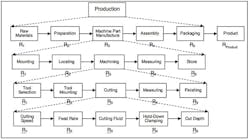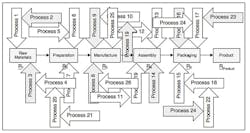“Chance of Success Mapping” is probably the most revolutionary of the concepts in my new book, Industrial and Manufacturing Wellness: The Complete Guide to Successful Enterprise Access Management, recently published by Industrial Press. It is certainly the one that will help managers most in making the best choices for their organization. Based on systems engineering and system reliability improvement, Chance of Success Mapping is the ideal technique for industrial operations, companies, and even global enterprises that seek optimal business solutions.
Every industrial and manufacturing business is a system. Such organizations are comprised of interacting processes, people, knowledge, and physical assets. To understand how business and work processes impact organizational success, you need to consider the interconnectivity and the resulting interactions of all processes used across the business’s life cycle to engineer the plant, buy equipment and raw materials, make the product range, and run the operation.
For the sake of an example, Figure 1 shows a simplified parts production system made up of processes. Figure 2 shows some of the sub-processes in the Manufacture step for making a mechanical machine part. It signifies that within each process are numerous tasks and their associated activities.
As Figure 3 highlights, there are also external processes that impact the core business. Figure 3 is a representation of the many supply chain and operational processes involved in making a product. Process after process connects with others in a tangled web of interaction across time and space. There are dozens and dozens of processes containing task upon task. There are hundreds of tasks in most businesses; many companies have thousands of them. Companies with highly complex operations—such as constructing large industrial process plants, constructing big power stations, and building spaceships or airplanes—have tens of thousands of activities to control.
Each task in each process presents an opportunity for things to go wrong. Because each process feeds many other processes, any error in one has a ripple effect that harms those downstream. And a process that goes wrong and is not corrected can impact numerous others in the future. For example, a poor maintenance repair can cause a future production failure; an operator error that overloads a machine can lead to a future breakdown; the wrong choice of construction materials by the designer of a gas-processing plant can contribute to a future explosion and possibly cause injuries to or even the death of people in and around the plant. That is why it is important for every step in a series process to go right every time—the future consequences are unforeseeable and can be devastating.
Like all organizations, the operation in this example wants to make products it is proud to put its name to as effectively and efficiently as possible. In a perfect world, it would make 100% of its production right the first time for the optimal least production cost. This would give the organization its largest margin and its largest profits. This would also mean that it has a perfect safety record, a perfect environmental record, and a perfect employee retention history, along with perfection in all the other factors that successful businesses want.
Perfection is a wonderful ideal. But in reality, what is the chance that any of an organization’s ideal outcomes are possible? That is where system reliability helps. With its estimation methods, you can understand what your odds are of having astounding business system success. Equally important as knowing how close to perfection we are in what we do, we also want to know what must be changed in the business, and by how much to change it, to achieve greater success.
Building More Successful Processes
Creating a more successful business means designing, then building, more successful processes. A successful process comprises correct inputs, effective tasks, knowledgeable people, and reliable machines—all working in concert. With the activities, equipment and processes in your company performing at world-class quality, world-class business results become natural.
Reliability is formally defined as the odds that an item of equipment will last long enough to do its stated duty. It is the chance of a physical thing remaining totally usable until a particular point in time. Reliability can also be used to measure a business system’s performance, because it is simply the likelihood of the system successfully delivering a desired result. Anywhere you want a specific result, you can determine the chance of the intended outcome actually happening.
Measuring the chance of business process or work success requires statistics and probability math. Such math can be difficult, but you need only simple multiplication to calculate reliability and see what chance you have of achieving work and process success in your organization.
The reliability of a series configuration is calculated by multiplying the reliability of each item in the arrangement. By using Formula 1, you can determine your chance of success from the steps in a process. By using Formula 2, you can gauge the chance of success for any of the tasks done in any process step. As soon as the reliability of any item in the series drops to zero, the whole series goes to zero, and the entire system is failed, or a job is scrap. The underscore distinguishes work task reliability (R) from system reliability (R), which does not use the underscore.
Formula 1
RProcess = R1 x R2 x R3 x ... Rn
Formula 2
RJob = R1 x R2 x R3 x ... Rn
Formula 1 enables you to identify where processes are weak, and Formula 2 lets you understand the circumstances when the tasks in a particular process has problems. With Formula 1, you can analyze the chance of success at any point in your business system, at any point in any of your processes, or at any point in your supply chain processes, and even at any point in your suppliers’ processes. With Formula 2, you can spot the process tasks causing a problem and then dig down into them to understand why the tasks are delivering muck.
To do a job perfectly, every task must be 100% right. In a series process—such as doing a repair job, operating a production line, using a supply chain, or running a business—when there is a mistake in one step, a defect is made or a problem is created, and the final outcome is wrong. This makes for a simple work reliability rule: the chance of job success is never greater than the chance of success for the worst-performed task. It is the same with every series arrangement: “One poor, all poor; one bad, all bad” is a reliability mantra to remember. It explains why you can have constant production quality problems. Make one error anywhere in a series work process, and the finished item will be defective.
To improve your business performance, you will need to work on the weaknesses in your own processes, and you will also need to go outside your company and work on the processes of your vendors and suppliers. You will need to make all the external processes excellent if you are to have operational excellence inside your company.
With system reliability engineering, you can map the chance of success occurring anywhere in your company. Once you know the problems you have, and why you have them, you are in the perfect position to determine what solutions are needed to eliminate your troubles forever—and to apply those solutions.
What is the chance that the processes you use will successfully deliver the intended results? In a process in which one step is done after the other and the failure of one step can fail the whole process, there are many opportunities for problems. In a series arrangement, the risks add together. Your total business risk is the sum of all of the risks in all of your business processes. The total risk to a production line is the sum of all of the risks in each production line step. The total risk for an equipment item is the sum of all of the risks from each of its components. Figure 4 is a process map depicting a five-task job. From such flowcharts you can gauge how successful the work, the job and the process will be.
To determine work task success rates, you collect data on work task failures. This lets you determine the likelihood of doing each task right, after which you can calculate the chance of doing the whole job right. If Task 1 has a 100% chance of perfect work, its probability of success is 1. If it is done right 50% of the time, it has a 0.5 probability of success. Formula 2 is used to calculate job reliability, or the chance of doing the whole job successfully.
If every task in Figure 4 has a 0.9 chance of success, the whole job reliability is calculated as follows:
RJob = 0.9 x 0.9 x 0.9 x 0.9 x 0.9 = 0.59 (59%)
Even at 90% certainty for each of the five tasks, the chance that the whole job will be done without error is a poor 59%. In other words, the job will be wrong 41 times for every 100 times it is done. To get a 90% success rate for the whole job, the calculation below warns us that each task will need a 98% chance of success—two errors in every 100 times it is done.
RJob = 0.98 x 0.98 x 0.98 x 0.98 x 0.98 = 0. 9 (90%)
As a job gets longer, each activity in it is another opportunity for mistakes. The more activities done in a job, the greater the opportunities to make errors and leave defects, and the fewer times the job will be done right. For a job of 12 tasks in length, with each task having 90% chance of success, its reliability is calculated below to be 0.28—it will contain defects and errors 72 times out of every 100 times it is done. To get the job success rate up to 90 out of a 100, every task will need to be 0.99 perfect—no more than 1 error in every 100 times it is executed.
RJob = 0.9 x 0.9 x 0.9 x 0.9 x 0.9 x 0.9 x 0.9 x 0.9 x 0.9 x 0.9 x 0.9 x 0.9 = 0.28 (28%)
If every task in our five task job is done right except Task 3, which is done correctly 60% of the time, the reliability of the job is as follows:
RJob = 1 x 1 x 0.6 x 1 x 1 = 0.6 (60%)
The chance of the whole job ending right is just 60%. All operating and maintenance work consists of tasks done in series, all of which have far more than the five steps in our simple example. Maintenance jobs of 40 to 50 tasks long, and often longer, are common. Unless every task is done right, the job will leave behind defects and mistakes. The high human error rates for repair work make breakdown maintenance and overhaul repairs very risky if you want maximum equipment reliability and utmost production uptime. Depending on the industry, early life failure of plant and machinery represent 50%-70% of all equipment failures, and is most often caused by bad work quality during a maintenance rebuild. Is it any wonder that many companies suffer from poor-performing operations when their managers, engineers, maintenance crews, and operators use failure-prone series processes?
If you want a company where great results are natural and excellence abounds, you have to ensure that your processes, jobs, and machines are built to deliver excellence. Every step in every process, every task in every job, and every part in your machines need to go right all the time. In the real world, that can only happen when your processes, work, and equipment are designed to deliver the right outcomes every time they are used.
Mike Sondalini is director of Lifetime Reliability Solutions Consultants and author of Industrial and Manufacturing Wellness: The Complete Guide to Successful Enterprise Access Management (Industrial Press, April 2016).








